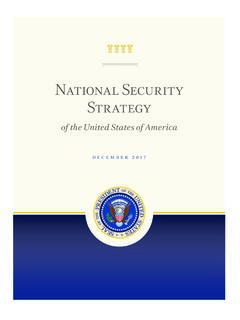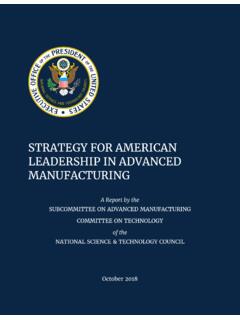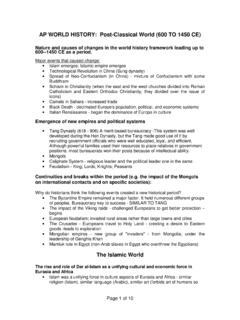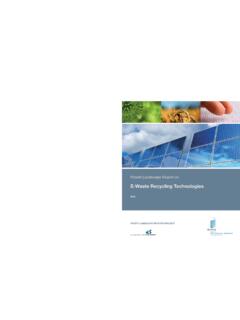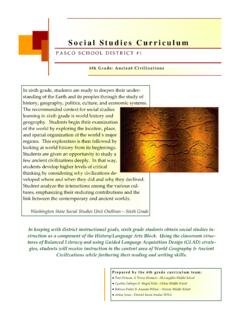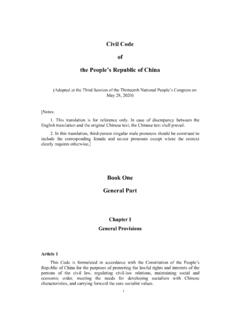Transcription of NATIONAL STRATEGY - Archives
1 NATIONAL STRATEGY for CRITICAL AND EMERGING TECHNOLOGIES OCTOBER 2 0 2 0 TECHNOLOGY RISK MANAGEMENT WORLD LEADER OF CRITICAL AND EMERGING TECHNOLOGIES PILLAR I PROMOTE THE NATIONAL SECURITY INNOVATION BASE Develop the highest-quality science and technology (S&T) workforce in the world Attract and retain inventors and innovators Leverage private capital and expertise to build and innovate Rapidly field inventions and innovations Reduce burdensome regulations, policies, and bureaucratic processes that inhibit innovation and industry growth Lead the development of worldwide technology norms, standards, and governance models that reflect democratic values and interests Support the development of a robust NATIONAL Security Innovation Base (NSIB)
2 , to include academic institutions, laboratories, supporting infrastructure, venture funding, supporting businesses, and industry Increase priority of research and development (R&D) in developing United States Government budgets Develop and adopt advanced technology applications within government and improve the desirability of the government as a customer of the private sector Encourage public-private partnerships Build strong and lasting technology partnerships with like-minded allies and partners and promote democratic values and principles With the private sector, create positive messaging to increase public acceptance of critical and emerging technologies (C&ET)
3 Encourage state and local governments to adopt similar actions PILLAR II PROTECT TECHNOLOGY ADVANTAGE Ensure that competitors do not use illicit means to acquire United States intellectual property, research, development, or technologies Require security design early in the technology development stages, and work with allies and partners to take similar action Protect the integrity of the R&D enterprise by fostering research security in academic institutions, laboratories, and industry, while balancing the valuable contributions of foreign researchers Ensure appropriate aspects of C&ET are adequately controlled under export laws and regulations, as well as multilateral export regimes Engage allies and partners to develop their own processes similar to those executed by CFIUS Engage with the private sector to benefit from its understanding of C&ET as well as future strategic vulnerabilities related to C&ET Assess worldwide S&T policies, capabilities, and trends, and how they are likely to influence, or undermine, American strategies and programs Ensure secure supply chains.
4 And encourage allies and partners to do the same Message to key stakeholders the importance of protecting technology advantage and offer practical assistance whenever possible TECHNOLOGY PEER TECHNOLOGY LEADER I TABLE OF CONTENTS INTRODUCTION .. 1 Unified with a NATIONAL STRATEGY .. 2 WORLD LEADER OF CRITICAL AND EMERGING TECHNOLOGIES .. 3 Technology Leader .. 3 Technology Peer .. 3 Technology Risk 4 PILLARS OF SUCCESS .. 5 PILLAR I: PROMOTE THE NATIONAL SECURITY INNOVATION BASE .. 7 Priority Actions .. 7 PILLAR II: PROTECT TECHNOLOGY ADVANTAGE .. 9 Priority Actions.
5 9 CONCLUSION .. 11 ANNEX: UNITED STATES GOVERNMENT CRITICAL AND EMERGING TECHNOLOGIES LIST .. A-1 1 INTRODUCTION Throughout our history, American achievements and leadership in science and technology (S&T) have been a driving factor for our way of life, prosperity, and security. However, American leadership in S&T faces growing challenges from strategic competitors, who recognize the benefits of S&T and are organizing massive human and capital resources on a NATIONAL scale to take the lead in areas with long-term consequences.
6 He NATIONAL Security STRATEGY (NSS) lays out a vision for promoting American prosperity; protecting the American people, the homeland, and the American way of life; preserving peace through strength; and advancing American influence in an era of great power competition. It calls for the United States to lead in research, technology, invention, and innovation, referred to here generally as science and technology (S&T), by prioritizing emerging technologies critical to economic growth and security. The NSS also calls for the United States to promote and protect the United States NATIONAL Security Innovation Base (NSIB), which it defines as the American network of knowledge, capabilities, and people including academia, NATIONAL Laboratories, and the private sector that turns ideas into innovations, transforms discoveries into successful commercial products and companies, and protects and enhances the American way of life.
7 Our market-oriented approach will allow us to prevail against state-directed models that produce waste and disincentivize innovation, but we will also protect ourselves from unfair competition and prevent the use of our technology for authoritarian activities. The People s Republic of China (PRC) is not only dedicating large amounts of resources in its pursuit to become the global leader in S&T. It is also targeting sources of United States and allied strength by employing means that include stealing technology, coercing companies to disclose intellectual property, undercutting free and fair markets, failing to provide reciprocal access in research and development (R&D) projects, and promoting authoritarian practices that run counter to democratic values.
8 The chinese government, in its quest to develop a world-class military by mid-century, is implementing a STRATEGY to divert emerging technologies to military programs, referred to as military-civil fusion (MCF). Russia views the development of advanced S&T as a NATIONAL security priority, and is targeting United States technology through the employment of a variety of licit and illicit technology transfer mechanisms to support NATIONAL -level efforts, including its military and intelligence programs. These actions include using illicit procurement networks, seeking technology transfer through joint ventures with Western companies, and requiring access to source code from technology companies seeking to sell their products in Russia.
9 With fewer resources at its disposal compared to the PRC, Russia is focusing its government-led S&T efforts on military and dual-use technologies, such as artificial intelligence, that T N A T I O N A L S T R A T E G Y F O R C R I T I C A L A N D E M E R G I N G T E C H N O L O G I E S 2 it believes will bring both military and economic advantages. Despite its focus on developing military versus civil applications, Russia recognizes the importance of industrial R&D. Russia plans to develop needed innovative technologies for its future military requirements by enabling its defense industrial base through civil-military integration.
10 In accordance with the NSS, we will maintain worldwide leadership in critical and emerging technologies (C&ET) by promoting our NSIB and protecting our technological advantage. For the purposes of this STRATEGY , C&ET are defined as those technologies that have been identified and assessed by the NATIONAL Security Council (NSC) to be critical, or to potentially become critical, to the United States NATIONAL security advantage, including military, intelligence, and economic advantages. The current list of C&ET is included in Annex A. The United States, with its allies and partners who share common open, democratic, and market-oriented values, will continue to lead the world in C&ET.



